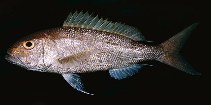| Family: |
Lutjanidae (Snappers), subfamily: Etelinae |
| Max. size: |
90 cm TL (male/unsexed); max. reported age: 30 years |
| Environment: |
demersal; marine; depth range 40 - 350 m |
| Distribution: |
Indo-Pacific: East Africa and Red Sea to Samoa, and southern Japan southward to Australia. |
| Diagnosis: |
Dorsal spines (total): 10-10; Dorsal soft rays (total): 11-11; Anal spines: 3-3; Anal soft rays: 8-8. Interorbital space flat. Lower jaw slightly protruding. Bases of dorsal and anal fin without scales, their last soft rays extended into shorts filaments. Pectoral fins long, reaching level of anus. Scale rows on back parallel to lateral line. Side of snout and cheek with 2 golden stripes bordered with blue. Top of head with a series of chevron-shaped yellow bands. |
| Biology: |
Gold band snappers are deepwater fish inhabiting tropical and sub-tropical waters. They are schooling fish and live in areas of hard, rocky and uneven sea floor and steep off islands (Ref. 27354). They feed on fishes, shrimps, crabs, lobsters, stomatopods, squids, gastropods and urochordates. Marketed fresh. An excellent food fish. Maximum depth from Ref. 082366. |
| IUCN Red List Status: |
Least Concern (LC); Date assessed: 05 March 2015 Ref. (130435)
|
| Threat to humans: |
harmless |
Source and more info: www.fishbase.org. For personal, classroom, and other internal use only. Not for publication.

